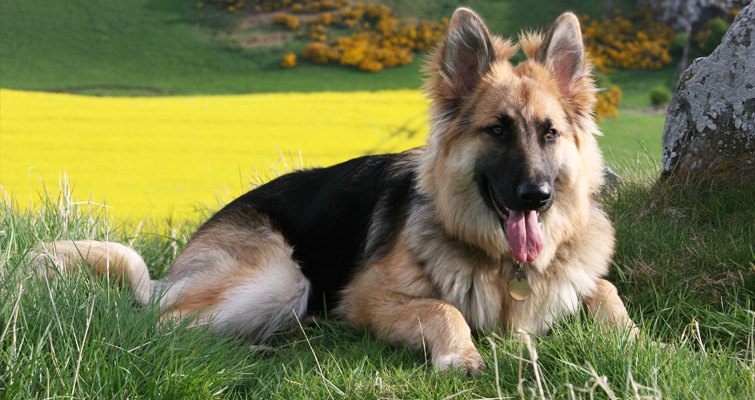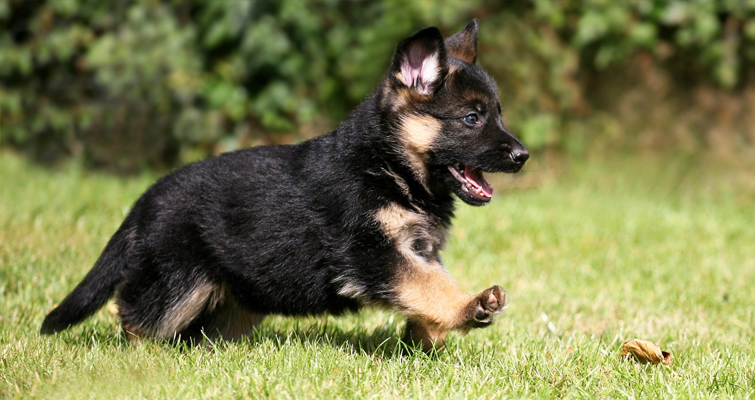
Call us Now ![]() +91-8744012053
+91-8744012053
Mon - Sat ~ 10:00 AM - 6:00 PM
Follow & Like
.png)


Call us Now ![]() +91-8744012053
+91-8744012053
Mon - Sat ~ 10:00 AM - 6:00 PM
Follow & Like
.png)


German Shepherd has achieved a legendary status as the ideal working dog due to his acute intelligence, courage and amazing versatility. This athletic and fearless breed excels almost anything he is trained to do like police and military service, search and rescue, competitive obedience, drug detection and, last but not least, faithful companion.

German shepherd’s abilities go far beyond its origin as a herding dog, as they have done extremely well in every canine sport, including obedience, agility, rally, tracking and, of course, herding. These protective but loving dogs are great choice for families with children, as well as singles and couples who love the outdoors. If you also want to be a proud owner of this amazing dog breed, then this article is a must read for you as it explains all important information about this energetic dog breed. Let’s begin.
| Breed Name | German Shepherd |
| Common Nicknames: | Alsatian, Berger Allemand |
| Group (Of Breed) | Herding, Working |
| Breed Type | Purebred |
| Colors | Most commonly tan with black saddle |
| Life span | 7 to 10 years |
| Height | Male: 24–26 inches (60–65 cm) Female: 22-24 Inches (50-60 cm) |
| Weight | Male: 22–40 kg Female : 22-40 kg |
| Good with Kids | Yes |
| Litter Size | 5-10 puppies |
As his name suggests, the German shepherd originated in Karlsruhe, Germany. This breed was created in the 19th century by Captain Max von Stephanitz, who wanted to develop a dog breed that could be used for police and military work. The end result was a dog that encompassed good looking, responsiveness, obedience, versatility and acute intelligence.
Origin

In April 1899, Captain Max von Stephanitz registered dog with name Deutsche Schäferhunde, which means “German Shepherd Dog” in English. The first German shepherd dog was shown in America in 1907 and the breed was recognized by AKC in 1908. This dog breed was also used in movies Strongheart and Rin-Tin-Tin, which brought a lot of attention, making it very popular
Description
Well proportioned and very strong breed, German shepherd has a muscular, sturdy, and slightly elongated body type with a light, solid bone structure. Their forehead is little rounded and nose is most often black. Their teeth meet in a strong scissors bite and dark eyes are almond-shaped, and never protruding. The ears of German shepherd are wide at the base, and upright, pointed and turned forward. The bushy tail of this muscular breed reaches below the hocks and it hangs down when the dog is at rest.
German shepherd’s thighs are thick and sturdy and front legs and shoulders are muscular. On the basis of coat type, there are three varieties of the German shepherd: plush coat, double coat and longhaired coat, which most often comes in black with tan, sable or all black as well as white, blue and liver color, but white, blue and liver colors are considered a fault according to most standards.
They have a double coat of medium length and the outer is dense. The hair of coat is straight, harsh and lying close to the body. The head of this dog, including the inner ear and muzzle and legs are covered with short hair, and their neck is covered with longer hair and thicker.
Living Conditions
The German shepherd is a big dog breed that needs ample space to play and exercise, therefore, this breed of dogs is more suited to an environment with plenty of room and a garden. They can also be kept in an apartment, if sufficiently exercised. These dogs are relatively inactive in indoors and do best with at least a big garden or yard.
Grooming
German shepherd dogs shed bits of hair constantly and are known as seasonal heavy shedder. These dogs should be brushed on daily basis otherwise you will have hair all over your home. Bathe only when necessary; because, over bathing of this breed can cause skin irritation due to oil depletion. You should check their ears and trim claws regularly.
Temperament
German shepherd dogs are keen, courageous, alert and fearless that makes them perfect working dogs. In addition to this, these dogs are obedient, cheerful, tranquil, confident, serious, clever and eager to learn. Extremely faithful and brave, this dog breed will not think twice about giving their lives for their owner. They love to be close to their families, but can be wary of strangers.
German shepherds need their owner and they should not be left isolated for long time period. Often used as police dogs, this breed is known for its strong protective instinct, and is extremely loyal to its handler. They only bark when they feel it is necessary and their aggression on people is due to poor handling. These dogs will not listen if they sense that they are stronger minded than their owner, therefore, owners need to have an air of natural authority to their demeanor.
Exercise
German Shepherds love strenuous activities that combined with training of some kind. These dogs need to be taken on a daily long walk or jogging. Most of these dogs love to play ball or Frisbee. Fifteen to twenty minutes of fetching along with daily pack walks will tire these dogs out quite nicely as well as give them a sense of purpose. You must be willing to provide some form of daily exercise, whether it is Frisbee catching, ball chasing, obedience training, or participation in a canine playgroup. If under-exercised, this breed of dogs can become restless and destructive.
Health Problems
German shepherd dog breeds are generally healthy, but like other breeds, they are prone to certain health problems. It’s important to be aware of following disease if you are considering this breed. However, not all German shepherds will get any or all of these diseases.
1. Home– You should provide a quiet environment when bringing your German shepherd puppy home. Preferably bring puppy home on a weekend so that you can spend more time with them.
2.Toilet Signs– Your puppy will need to go to the bathroom as soon as they start eating or drinking anything. The puppies will show signs of needing to go, sniffing, circling, scenting. You should remain observant and look out for these cues. Some puppies learn potty training quickly, others don’t, so be prepared to stock up on puppy pads for those incidents.
3.Toilet Stops– You should an area outside of home that will be become your puppies’ toilet area and take them to that place after every drink or meal and praise your puppy for this. Your puppy will soon learn that this is their toilet spot.
4.Bedtime– It’s quite common for your puppy to whine when you first bring him home. Being alone in for the first time will be pretty frightening for your puppy, therefore, to ease their fears include bedding, preferably with the mother’s scent if available.
5.Routine– German Shepherds are confident dogs and they need to be shown that you are their leader early on. From toilet times and feeding to playtime and walks, proper routine should be introduced in all aspects of the normal day. You should keep in mind that consistency is the key to train dog.
[…] 9.German Shepherd […]
[…] German shepherd is an extremely affectionate and devoted breed that requires its master to reciprocate all the love and care. All German shepherd dog owners and those who are contemplating to adopt one must be mindful of a few tips that will help in a healthy and wholesome lifestyle for the pet dog. […]